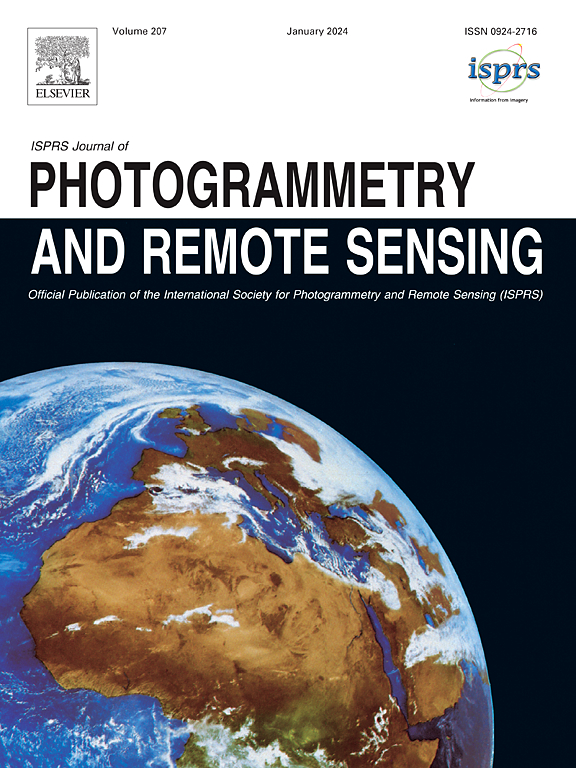通过基于 PolSAR 模型的分解估算月球表面独特的介电常数
IF 10.6
1区 地球科学
Q1 GEOGRAPHY, PHYSICAL
ISPRS Journal of Photogrammetry and Remote Sensing
Pub Date : 2024-11-22
DOI:10.1016/j.isprsjprs.2024.10.022
引用次数: 0
摘要
地球和行星表面的介电常数过去一直使用反射系数来估算。最近的趋势是使用基于模型的分解方法从偏振合成孔径雷达(polSAR)数据中检索介电常数。我们研究了这方面的文献,提出了一种使用三分量分解技术的独特介电常数估计(UDCE)算法。在 UDCE 算法中,介电常数直接从测量到的相干矩阵的一个元素中一步获得。当单弹跳或双弹跳散射占主导地位时,UDCE 得出的介电常数估计值与体积散射模型无关。这就避免了高估体积散射对共极化比率,进而对介电常数造成的误差传播,而这种误差传播是已报道的使用基于模型分解的算法所固有的。因此,我们获得了唯一的解决方案。我们还证明,使用基于模型的高阶分解,UDCE 的解不会受到影响。我们使用 Chandrayaan- 2 双频合成孔径雷达 (DFSAR) 数据集对阿波罗 12 号、阿波罗 15 号和阿波罗 17 号在月球表面的三个着陆点评估了所提出的 UDCE 算法的性能。所有三个测试点的介电常数估计都保持了极佳的收敛率。利用所提出的 UDCE 算法,首次使用完整的 polSAR 数据生成了月球表面的介电常数图。我们观察到,生成的介电常数图捕捉到了所有地面实况特征,而这些特征以前从未如此清晰地呈现过。本文章由计算机程序翻译,如有差异,请以英文原文为准。
A unique dielectric constant estimation for lunar surface through PolSAR model-based decomposition
Dielectric constant for the earth and planetary surfaces has been estimated using reflection coefficients in the past. A recent trend is to use model-based decomposition for dielectric constant retrieval from polarimetric synthetic aperture radar (polSAR) data. We examine the reported literature in this regard and propose a unique dielectric constant estimation (UDCE) algorithm using three-component decomposition technique. In UDCE, the dielectric constant is obtained directly from one of the elements of the measured coherency matrix in a single step. The dielectric constant estimate from the UDCE is independent of the volume scattering model when single-bounce or double-bounce scattering is dominant. This avoids error propagation from overestimation of volume scattering to the copolarization ratios, and in turn, to the dielectric constant, inherent in reported algorithms that use model-based decomposition. Consequently, a unique solution is obtained. We also demonstrate that the solution from the UDCE is unaffected by using a higher-order model-based decomposition. We evaluate the performance of the proposed UDCE algorithm over three Apollo 12, Apollo 15, and Apollo 17 landing sites on the lunar surface using Chandrayaan- 2 dual-frequency synthetic aperture radar (DFSAR) datasets. An excellent convergence rate for dielectric constant estimation is maintained over all three test sites. Using the proposed UDCE algorithm, the dielectric constant maps are produced for the lunar surface using full polSAR data for the first time. We observe that the generated dielectric constant maps capture all the ground truth features, previously unseen with such clarity.
求助全文
通过发布文献求助,成功后即可免费获取论文全文。
去求助
来源期刊

ISPRS Journal of Photogrammetry and Remote Sensing
工程技术-成像科学与照相技术
CiteScore
21.00
自引率
6.30%
发文量
273
审稿时长
40 days
期刊介绍:
The ISPRS Journal of Photogrammetry and Remote Sensing (P&RS) serves as the official journal of the International Society for Photogrammetry and Remote Sensing (ISPRS). It acts as a platform for scientists and professionals worldwide who are involved in various disciplines that utilize photogrammetry, remote sensing, spatial information systems, computer vision, and related fields. The journal aims to facilitate communication and dissemination of advancements in these disciplines, while also acting as a comprehensive source of reference and archive.
P&RS endeavors to publish high-quality, peer-reviewed research papers that are preferably original and have not been published before. These papers can cover scientific/research, technological development, or application/practical aspects. Additionally, the journal welcomes papers that are based on presentations from ISPRS meetings, as long as they are considered significant contributions to the aforementioned fields.
In particular, P&RS encourages the submission of papers that are of broad scientific interest, showcase innovative applications (especially in emerging fields), have an interdisciplinary focus, discuss topics that have received limited attention in P&RS or related journals, or explore new directions in scientific or professional realms. It is preferred that theoretical papers include practical applications, while papers focusing on systems and applications should include a theoretical background.
 求助内容:
求助内容: 应助结果提醒方式:
应助结果提醒方式:


